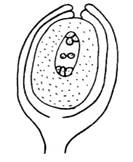Questions on Reproduction in Flowering Plants: MCQs on Sexual Reproduction in Flowering Plants (Angiosperms) in quiz format with answers, Test No. 04
Find more questions on this topic
Reproduction in Flowering Plants (Angiosperms) : Quiz 05
Congratulations - you have completed Reproduction in Flowering Plants (Angiosperms) : Quiz 05.
You scored %%SCORE%% out of %%TOTAL%%.
Your performance has been rated as %%RATING%%
Your answers are highlighted below.
Question 1 |
The arrangement of the nuclei in a normal embryo sac in the dicot plants is
2 + 3 + 3 | |
3 + 2 + 3 | |
2 + 4 + 2 | |
3 + 3 + 2 |
Question 2 |
Apomictic embryos in citrus arise from
Maternal sporophytic tissue in ovule | |
Synergids | |
Diploid egg | |
Antipodal cells |
Question 3 |
Fibrous thickenings of hygroscopic nature are found in this part of the anther wall:
Middle layers | |
Endothecium | |
Epidermis | |
Tapetum |
Question 4 |
In a type of apomixis known as adventive embryony, embryos develop directly from the
Zygote | |
Nucellus or integuments | |
Synergids or antipodals in an embryo sac | |
Accessory embryo sacs in the ovule |
Question 5 |
In nature, cleistogamous flowers are
wind pollinated | |
insect pollinated | |
self pollinated | |
bird pollinated |
Question 6 |
Which one of the following is surrounded by a callose wall?
Male gamete | |
Microspore mother cell | |
Pollen grain | |
Egg |
Question 7 |
Study the following table and select the most correct option given below the table.
| List –I | List –II |
| (Structure before seed formation) | (Structure after seed formation) |
| A. Funiculus | I. Hilum |
| B. Scar of Ovule | II. Tegmen |
| C. Zygote | III. Testa |
| D. Inner integument | IV. Stalk of seed |
| V. Embryo |
A - V, B - I, C - II, D - IV | |
A - III, B - IV, C - I, D - V | |
A - IV, B - I, C - V, D - II | |
A - IV, B - V, C - III, D - II |
Question 8 |
Amphitropous ovule | |
Orthotropous ovule | |
Anatropous ovule | |
Campylotropous ovule |
Question 9 |
What is the function of germ pore?
Initiation of pollen tube | |
Absorption of water for seed germination | |
Emergence of radicle | |
Release of male gametes |
Question 10 |
Which of the following pairs in angiosperms are diploid and triploid, respectively?
Polar nucleus and secondary nucleus | |
Microspore mother cell and egg cell | |
Secondary nucleus and endosperm | |
Endosperm and antipodal cells |
Question 11 |
Which of the following statements about sporopollenin is false?
Exine has apertures called germ pores where sporopollenin is present | |
Sporopollenin is one of the resistant organic materials | |
Exine is made up of sporopollenin | |
Sporopollenin can withstand high temperatures and strong acids |
Question 12 |
Which one of the following is not a correct explanation of cross pollination?
The pollen grains of male flowers are transferred to the stigma of the female flowers | |
The pollen grains are transferred from one flower to another flower, of another plant of the same species | |
The pollen grains are transferred from one flower to another flower situated on the same plant | |
The pollen grains of one flower are transferred to the stigma of the same flower |
Question 13 |
Which one of the following pairs of plant structures has haploid number of chromosomes?
Egg cell and antipodal cells | |
Megaspore mother cell and antipodal cells | |
Egg nucleus and secondary nucleus | |
Nucellus and antipodal cells |
Question 14 |
Which one of the following statements is wrong?
Intine is made up of cellulose and pectin | |
Vegetative cell is larger than generative cell | |
Pollen grains in some plants remain viable for months | |
When pollen is shed at two-celled stage, double fertilization does not take place |
Question 15 |
Assertion: 7-celled, 8 nucleate and monosporic embryo sac is called Polygonum type of embryo sac.
Reason: It was discovered by Hofmeister for the first time in Polygonum.
Both Assertion and Reason are true and Reason is the correct explanation of the Assertion. | |
Both Assertion and Reason are true but the Reason is not the correct explanations of Assertion. | |
Assertion is true, but Reason is false. | |
Both Assertion and Reason are false. |
Once you are finished, click the button below. Any items you have not completed will be marked incorrect.
There are 15 questions to complete.




sir,in Q.No. 12 there two option because in option ‘c” means GEITONOGAMY which is a part of self pollination . Hence option no.”c” &”d” both are right
Gud paper
QUESTION ARE GOOD,PLESE PROVIDE TRICKY QUESTION,LIKE QN NO 1………….
its really a good revision.